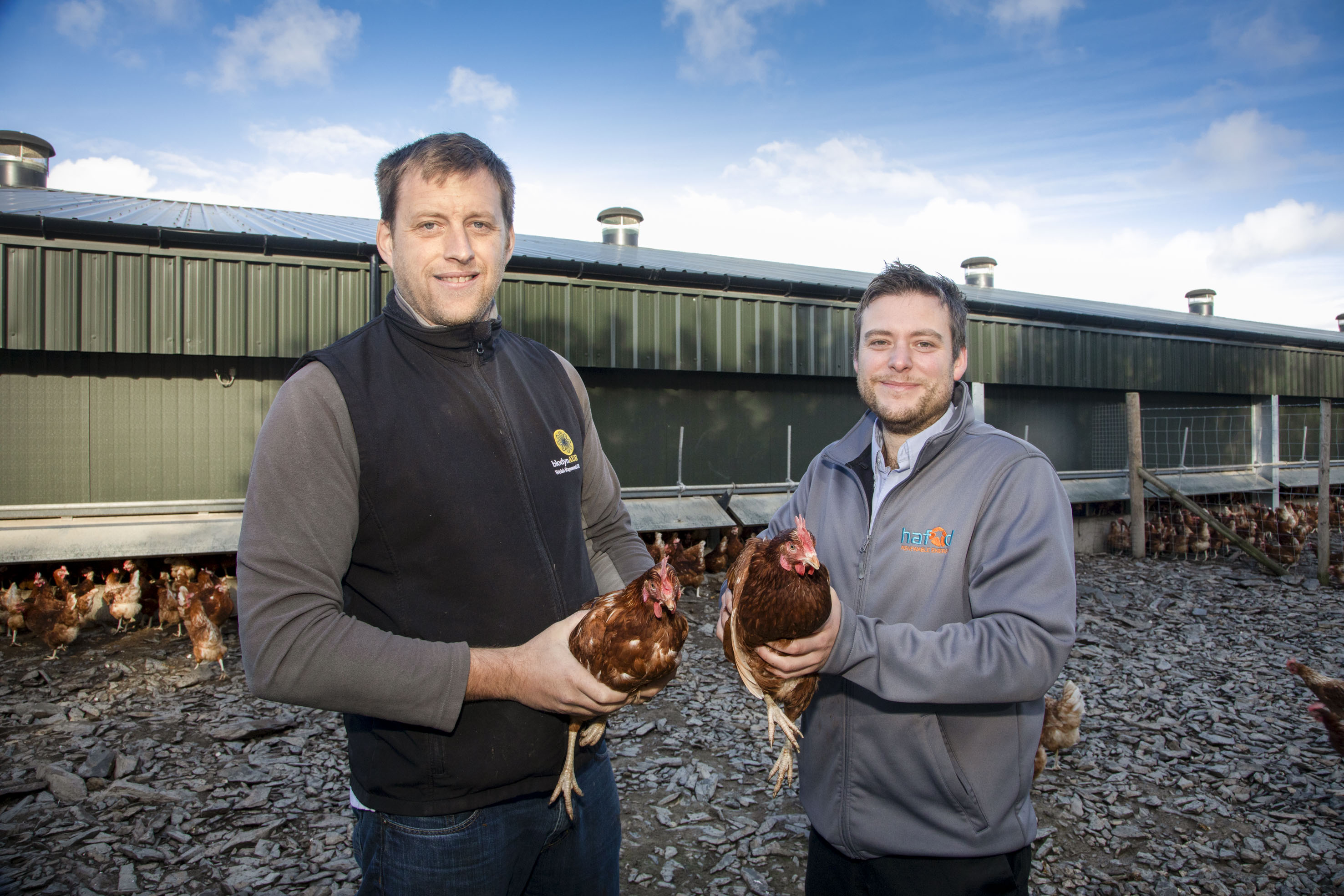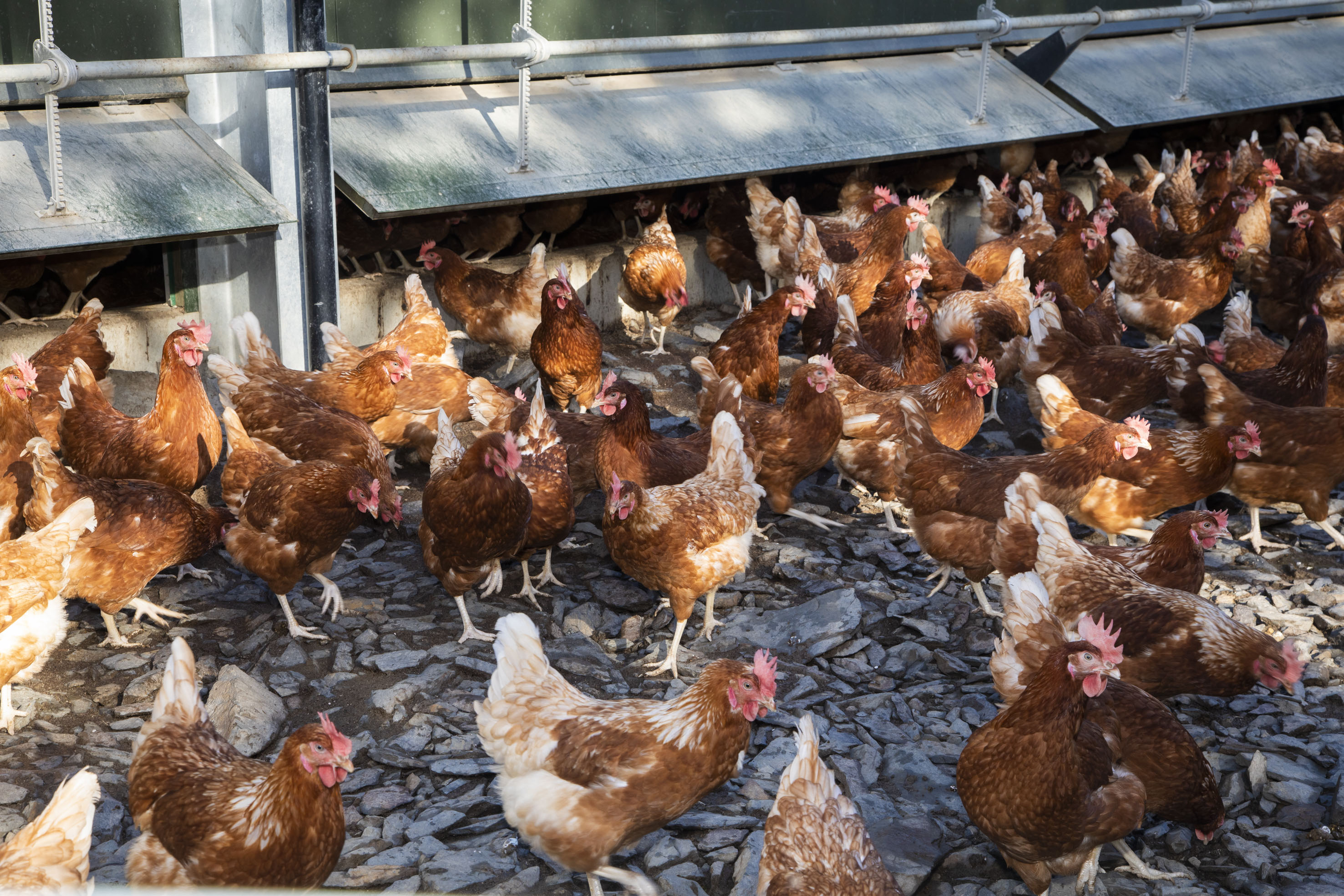



How solar lightens the load for free-range egg farming
For free-range farmers, solar energy and ground-source heating could prove a powerful combination.For free-range producers, solar energy and ground-source heating could prove a powerful combination – both in saving on emissions and saving on costs – as one egg farm in North Wales demonstrates.
Nestled in the rolling hills of North Wales are 16,000 chickens foraging on 20 acres of green, sloping pasture overlooking the gentle peaks of Conwy County Borough’s agricultural countryside.
Watching over these hens is farmer Llyr Jones near Llanfihangel Glyn Myfyr, who farms 1,600 acres and whose portfolio of produce also includes sheep and Wales’s own cold-pressed rapeseed oil, called Blodyn Aur, of which Llyr produces 6,000 bottles a year.
Farming since he could walk, Llyr has got into egg production over the last three years, seeking to diversify his enterprise in the light of uncertainties around Brexit and the falling price of lamb and beef, as well as reductions in subsidies.
Even without such uncertainties, egg producers are under constant pressure. Whether ensuring optimal performance or keeping strict biosecurity, the last thing any farmer needs is financial uncertainty.
In an effort to reduce this pressure and for greater on-farm efficiency, Llyr reached out to Hafod Renewables, a leading, Wales-based installer of renewable-energy technologies run by father and son Richard and David Jones.
The result of their collaboration? Low-cost, passive heating supplied to Llyr’s free-range layer house by means of 2,000 metres of piping, buried a metre beneath the ground (upon which sheep are now happily grazing), and a heat exchanger, which is further powered by solar panels on top of the house.

Hassle-free heating
Compared to conventional heating systems, ground-source heating requires little to no maintenance. There’s an annual inspection conducted by the installer, and aside from the initial set-up, not much is required of the producer in terms of daily duties.
Discussing the initial set-up, David points to two big black pipes next to where we are sitting in Llyr’s farm office. “Those pipes go out into the field where [the rest of the] pipework is buried… That all had to get buried, so there was a lot of excavations and civil works, filling with sand and back-filling.
“Then we had to fit the heat pump, which collects all the hot water and distributes it to the heating systems, which are fan blowers all around the property. It took about three to four weeks to instal, but it’s all fairly straightforward,” says David.
Llyr says: “I looked at biomass, where you cut trees and put them in the boiler. I have a few friends doing that. One friend – he’s constantly chainsawing and cutting trees and every day he’s having to load it up and check on things. The price of wood has shot up too.
“He’s… well, you can tell he’s getting fed up with it. But for this, I don’t have to do anything. Like on Sunday I’d rather be in bed than having to get up and feed the boiler,” adds Llyr.
When it came to the initial set-up, Llyr says the only obstacle was the terrain: “We have a lot of rocks.”
Cost savings
In addition to being easy to set up, the benefit of using ground source heating in terms of cost is hard to deny. “It’s free energy once you set it up. And it’s pretty much free to run,” says David. Especially if you pair it with something like solar panels, adds Llyr.
Up front, the cost is around £55,000, which includes the pipework, fitting out and all the internal works, but with the UK’s Renewable Heat Incentive Scheme (RHI), producers can expect to save thousands per year.
Ground-source heating is 70 percent cheaper than direct electricity, 50 percent cheaper than oil and 60 percent cheaper than LBG (low-BTU gas). All totalled, producers can save between £7,000 and £11,000 per year, says David.
Hafod is not just a fitter and installer, adds David, but also services the system, has a crew ready to hand in case of any breakdowns and offers maintenance for anything to do with the heat pump – and they even offer support with the documentation to get the grants from the RHI.
Savings can be turned into profit as well, it seems. The more integrated, the better, and Llyr is actually producing more power than he uses between his solar panels and a small hydro set-up he also operates when the creek runs in the spring.
The cost savings are even greater when compared to other types of heating and the inputs they require, such as biomass, which requires large quantities of purchased wood bulk and conventional heating with oil. In both cases, the purchase of commodities is required, “Whereas with ground source, the ground recharges heat so you can be self-sustaining,” says David. “It’s produced on the farm without bringing anything in. You just turn it on and that’s it.”
This also gives the farmer greater independence, adds Llyr.

Environmentally friendly egg production
With consumers demanding more from producers than ever before, not only in terms of cheap, healthy and safe food, but also environmental sustainability, producers are under pressure to find all-encompassing solutions.
Speaking to the environmental footprint of biomass heating, David says: “There’s also the carbon cycle to consider. Trees absorb carbon, but this is released when they’re cut down and burned.
“You also have to consider the actual air quality. It’s as bad as car emissions. Not to mention having to transport all that wood, sometimes from Canada, considering we don’t produce enough of it [in the UK] to supply ourselves.”
Llyr is also interested in marketing his eggs as not only high welfare (being free range), but also as environmentally friendly, which many food-assurance schemes are pushing to incorporate into their labelling, such as the Soil Association and LEAF.
One thing to consider is how ground-source heating affects the soil. There is a concern that it might contribute to frost, with too much heat being removed from the ground. However, this should be avoided by burying enough piping. “Too little pipework could possibly lead to some frost and freezing, but we put 2,000 metres of piping in there so there’s no chance that’s going to happen,” says David.
“We do check the geology beforehand, so we can make recommendations based on that as well,” he adds.
Llyr adds that he’s seen other free-range egg producers who have installed ground-source heating on their ranges. He noticed on one farm that trees planted over the piping grow slower than trees planted at the same time on parts of the range where there was no buried pipework.
Llyr and David agree this could be due to some minor moisture loss, but that planting trees over the pipework is inadvisable anyway since when in full leaf the trees would shade the ground, cooling it and reducing the amount of heat carried back to the layer house.
That said, grass returns in short order after the pipes have been buried and may be pastured with sheep or chickens as normal.
Ultimately, however, ground-source heating can actually be considered 100 percent renewable, say David, if the energy used to power the unit is derived from renewable sources. Providers such as Bulb and Octopus can offer this, and using a renewable supplier means that the ground-source heating is a carbon-neutral, sustainable form of heating.

Ammonia reduction and performance
Despite this system being easy to set up, cost effective and environmentally friendly – it has to work for the producer in terms of performance. If a technology doesn’t improve production in some capacity, many will not implement it.
Llyr addresses this too, however, and has observed two fundamental improvements since installing ground-source heating.
“My litter is a lot drier than normal, which helps with my ammonia levels and that has become an issue in Wales.”
Lower ammonia levels translate into healthier birds, and Llyr’s also noticed an improved eggs-per-bird ratio.
Because they’re warmer, he says, they’re eating less and putting less energy into keeping warm: “10 percent here, 10 percent there – it all adds up. Looking at our last flock, before we had the ground-source heating, we’re now producing 11 eggs per bird more. That’s a few thousand pounds extra,” says Llyr.
“Our last flock also had more birds. So we have less birds now, but more eggs in total.”
Llyr plans to build a second layer house with the same set-up of ground-source heating and solar panels. Llyr’s egg production will be among over 100 other farms across Wales that have had Hafod Renewables instal ground-source heating systems on their land.
“We’re just farming the sun’s energy, really. The sun shines, the grass grows and we turn that energy into food. Now I’m not only farming food, but energy too. It’s great,” concludes Llyr.









